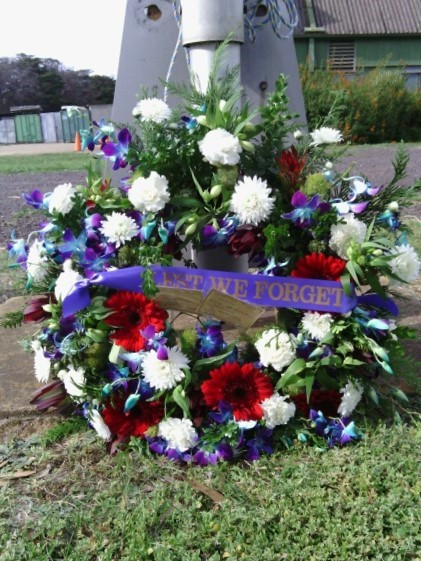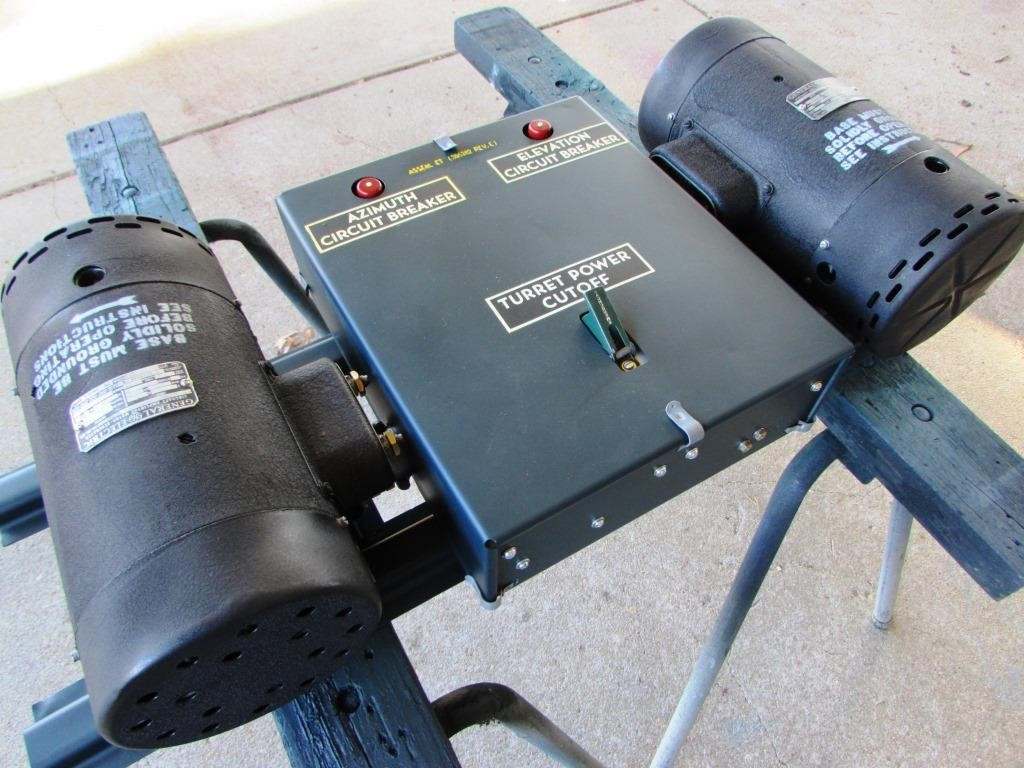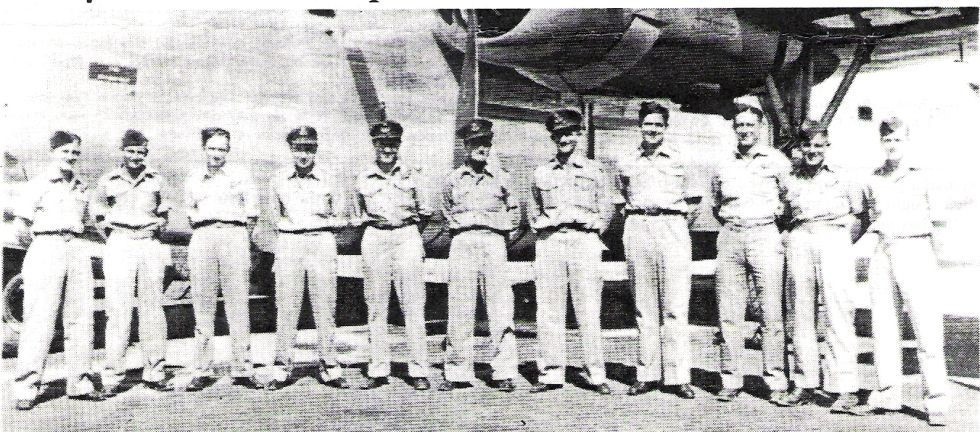May/June 2020 Newsletter
Membership Matters.
ANZAC Day memorial service.
On ANZAC day a small group convened at the hangar and carried out the traditional service of raising the flag and playing The Ode. A wreath was laid and an anonymous person had festooned the gate with poppies.
We did not let this day pass without a service of remembrance and respect.
Membership annual renewals.
Just a reminder.
The address for remittances is:
Bank of Melbourne.
BSB: 193 879
Account 415 686518
Account name. B-24 Liberator Memorial
Australia inc.
Or
Contracts Manager.
PO Box 156, Werribee, Vic. 3030.
Lest we forget.
Hangar news.
Our second remote (via email) committee meeting was held on 16 May. This new way of doing business was a bit strange to start with but, with guidelines established and confidence gained, a lively and productive meeting was achieved and was completed within the time agreed too. Our main business was discussing the hangar re-opening, OH&S responsibilities and hangar security.
A “Flyer” was distributed to our hangar volunteers about the meeting, keeping them in touch and involved.
The items stolen from the hangar will be returned to us after the Police have taken finger prints and made a few inquiries This is a good result.
Our third (via email) committee meeting was held on 13 June. A range of items was discussed, mainly centred on Coronavirus concerns. It was decided to delay the opening of the hangar to visitors until the results of the Melbourne protest march are known. The hangar will remain open for our volunteers who will practise safe distance and sanitising protocols.
We have lodged an External Fund application with the National Trust requesting approval to enlarge our appeal base to cover museum precinct development more generally, including fit out of the interior of the restored Hangar 1.
The items stolen from the hangar have been returned to us by Victoria Police, and we thank all concerned in the recovery. Additional security methods have been implemented as a result of this incident.
Museum precinct news.
In early May Melbourne Water notified us of the sub-contractors appointed to the Hangar 1 relocation and restoration project. We much appreciate the good communication with MW.
In addition, on 19 May we received a request from the Project Team to describe what our activities plan is for Hangar 1 from the day it is handed over!!! Now that was a confidence booster.
B-24 Liberator, 2020 work plan.
Understandably, the work plan is now on hold. Ideas and suggestions would be appreciated during this time.
Tasks have recommenced in a limited fashion as volunteers have begun returning to the hangar.
Work is continuing off site on the replica armament, and development of the intake duct mock-up was successful after a trial fitment on the aircraft. Also work is proceeding on the repair and overhaul of the nose turret amplidynes, below.
Oxford, 2020 work plan.
Unfortunately, as above.
However, we have been contacted by a group in England who are also restoring an Oxford. They have suggested we find ways to communicate on ideas and technical support.
The group is called “Saving Amy” and can be Googled as “Saving Amy, Oxford project”.
Museum activities.
Cataloging of our artifacts has recommenced.
Just for information.
Looking around the world at all the commercial aircraft allocated to airfields for storage and maintenance activities reminded me of a conversation I had with a Willow Run veteran.
At the end of WWII she worked in the logistics section, receiving department. She explained the situation that they could not stop the supply of B-24 parts and sub-assemblies to that facility. This came about because the suppliers’ contracts stated that payment could only be made upon delivery and acceptance at Willow Run. Willow May/June 2020. Run had successfully delivered the completed B-24s but were left with incomplete major components. This situation rapidly consumed all the available floor space.
As Consolidated, now Convair, was tooling up to manufacture the giant B-36 Peacemaker bomber, the situation was critical. She did not know the final outcome as she left to start her family.
Forthcoming events .
None planned.
For Gabrielle.
A mystery solved.
A few years ago, during a visit to Scotland, we took my aunt and uncle out for lunch. We stopped at a little town near Paisley. After lunch the ladies went shopping while my uncle and I found a seat at the town centre. “Dave,” he said. “Have you noticed the number of red heads about in this town?” “Around 1964 a national survey found this town had the largest percentage of red-haired people in the UK.” This aroused a great deal of interest from medical and science researchers. The result was that a survey was carried out in the town and surrounding districts to ascertain: When did it start? “About 1942” (in the middle of WWII) was the general response. Were there any ammunition factories nearby? “No,” was the response. Were there any chemical factories nearby? Again, “no” was the response. Were there any top-secret activities? Again, “no.”
A disappointed survey team packed up and prepared to depart. Prior to leaving, they called in at a local pub. An elderly local sat at a table with his beer and started a conversation with the survey leader. “I can give you the answer,” the old fellow said, “It was the postman.”
My mum.
My parents recently retired. Mum always wanted to play the piano, so dad bought her one for her birthday. A few weeks later I asked how she was doing with it. “Oh, we returned the piano,” said my dad. “I persuaded her to change to a clarinet instead.” “How come?” I asked. “Because, with the clarinet, she can’t sing.”
The French connection continues.
A72-133’s main undercarriage leg as displayed in a local village after its forced landing on a reef, Cape Nangeh, Sombea Island on 26 May 1945. The crew survived to serve out the war as POWs.
A72-133 was attached to 25 Squadron based at Cunderdin in Western Australia.
Monsieur Claude Bernard is still hopeful that a photograph of A72-133 can be located for his use.
Not forgotten.
A 25 Squadron crew at Cunderdin WA. Sgt. ‘Lockie’ O’ Loughlin, Nose gunner. Sgt. Cassidy. LAC A. Burns, Engineer/fitter. F/O Ken A. Barton, 1st Wireless operator. F/O Alex J. Walker, Navigator. F/LT Vesy J. Allen, Captain. F/LT Ron R. Alcock, Co-pilot. Sgt Andy Burke, Bomb aimer. Sgt Jim Gozzard, Mid upper gunner. Sgt Scotty Pratt, Tail gunner. Sgt A.R. ‘Sandy’ Baxter, 2nd WOP.
A blast from the past.
Enthusiastic rendering of a grinder on our front fuselage during the initial clean-up activity.
This was the start of the massive task required to restore our aircraft to museum standard.
It is worth noting that this is the only B-24 Liberator fuselage that has been completely de-skinned to allow the structure to have the corrosion treated and damaged parts replaced or repaired. The skins were similarly treated prior to re-fitment and riveting to the structure. The tail plane and fins were beyond saving and were carefully dismantled to the basic details. These details were used as patterns to manufacture new items. Wooden form blocks were created to cater for complicated curves and angles. Jigs with critical dimension requirements were created and assembled in house.
When required, engineering drawings had to be sourced from the USA. At that point in history we did not have the luxury of computer-sourced instant answers (thanks to Google and G-mail).
The wings eventually obtained and fitted were in a better condition than the fuselage and are being treated for minor corrosion and re-protected.
The centre section exhibits evidence of battle and fire damage.
During this time a myriad of smaller items, instruments, pumps, wheels, hydraulic items and components, were being dismantled, cleaned, repaired, re-assembled and painted.
Engines were obtained in various conditions and each one required careful and detailed overhaul and re-assembly to ensure they could be run safely and efficiently in public at a later date.
The other international surviving Liberators were obtained in a serviceable condition from active military resources with maintenance and repair history available.
President’s message.
With the easing of Coronavirus restrictions in Victoria, we are pleased that a number of volunteers have returned to work at the restoration hangar. The sounds of a working restoration museum will gladden many hearts!
Of course, we miss visitors, and we are considering when we shall be in a position to re-open to them, while observing government requirements.
We have developed protocols for volunteers back in the hangar to minimize risk (a maximum of 20 at any one time, hand washing and sanitising, frequent cleaning of surfaces, tools, etc., social distancing). We shall do the same when we re-open to visitors.
We are pleased that we have managed to continue with various aspects of our work while the hangar was closed. I am especially grateful to Committee members who patiently participated in email meetings, kept an eye on the hangar, ensured access, when required, for Melbourne Water sub-contractors, and to others who assisted by, e.g., keeping grass mown around the hangar. By no means have we ‘ground to a halt’ since March; we have actually achieved a lot. You will have read of some of the areas of activity elsewhere in this Newsletter.
I am also delighted many members have renewed their memberships during this period – thank you!
Once we are prepared for welcoming visitors to the hangar again, we shall announce this on our website and Facebook page. In the meantime, I wish you good health and contentment in whatever you are doing.
Lyn Gorman, President









